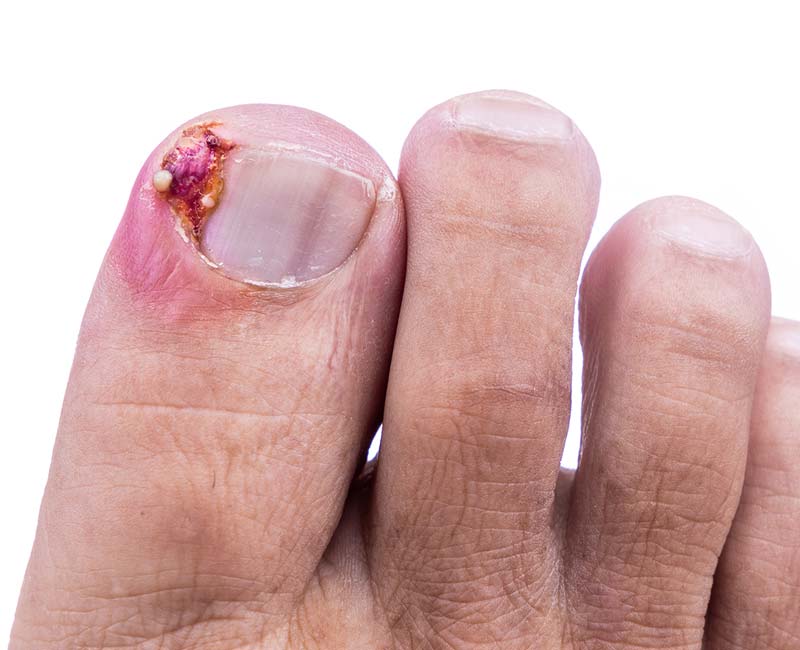An ingrown toenail is when the corner of your toenail grows into your skin. It’s a common condition that happens frequently when you cut your toenails by tapering around the corners. Ingrown toenails usually aren’t serious and you can typically treat them at home. If you have diabetes or you think you have an infection, see a healthcare provider.
Advertisement
Cleveland Clinic is a non-profit academic medical center. Advertising on our site helps support our mission. We do not endorse non-Cleveland Clinic products or services. Policy

An ingrown toenail is a foot condition that develops when the corner of your toenail grows down into your skin. It usually affects your big toe, but it can affect any of your toes.
Advertisement
Cleveland Clinic is a non-profit academic medical center. Advertising on our site helps support our mission. We do not endorse non-Cleveland Clinic products or services. Policy
The condition often happens when people cut their toenails by rounding (tapering) the corner of their nails. If the toenail curves with the shape of your toe, it can grow into your skin. Ingrown toenails are common and don’t usually pose a health risk to healthy people.
Anyone can get an ingrown toenail. People at a higher risk include adolescents, athletes and people who have:
Ingrown toenails are a common foot problem. Two out of every 10 people who see their healthcare provider for a foot issue go in for this condition.
Ingrown toenails can have many causes. These may include:
An ingrown toenail grows into the skin around your nail bed. You may see redness and swelling around that area of your toe.
A mild ingrown toenail can feel hard and swollen. If the nail grows into your skin, or the skin grows over your nail edge, bacteria can enter. The nail may become infected. Infected ingrown toenail symptoms may include:
Advertisement
This foot condition usually doesn’t cause any complications in healthy people. You may develop an infection around your nail or scarring of your nail fold. In rare, chronic cases, an ingrown toenail infection can spread through your toe and into your bone.
You can often diagnose the condition yourself, based on your symptoms and how your toe looks and feels.
Your healthcare provider (which may be your regular provider or a foot specialist called a podiatrist) will likely diagnose an ingrown toenail by inspecting it. They’ll examine the skin at the edge of your nail. They’ll diagnose you with this foot condition if the skin is:
You typically don’t need any tests or X-rays to diagnose an ingrown toenail. In rare cases, when your toenail is severely infected, your healthcare provider might take a sample of the discharge or nail itself. They’ll run a bacteria culture test or sometimes a fungal culture to identify what’s causing the infection. You may need X-rays for more serious infections.
Ingrown toenail home treatment includes several simple steps. These steps can help manage the infection and prevent further ingrown toenail pain.
If you have signs of infection or a severe ingrown toenail, don’t attempt to cut it yourself. If you cut the nail, the condition may get worse. If symptoms aren’t getting better with home remedies for an ingrown toenail, see a healthcare provider.
If your symptoms haven’t improved within a few days, or the nail looks worse, call your healthcare provider.
You should also see your provider as soon as possible if you develop an ingrown toenail and you have:
Most of the time, healthcare providers can treat mild ingrown toenails using the same techniques you would at home. But they use sterile and more professional instrumentation. This foot condition usually heals without surgery.
Advertisement
In severe cases, your healthcare provider may need to remove part of your nail surgically through a procedure called nail avulsion. Ingrown toenail surgery keeps the edge of your nail from growing inward and cutting into your skin.
During a partial or complete nail avulsion, your provider will inject a numbing medicine (anesthetic) into your toe. Then, they’ll cut away part or all of your toenail. It can take a few months for your nail to regrow. If the condition keeps occurring, your provider can perform permanent ingrown toenail removal with the assistance of a chemical to kill the nail root.
Most of the time, this foot condition isn’t a serious health problem. Ingrown toenail treatment usually works. Your ingrown toenail won’t grow back if you practice good foot care.
You may need regular foot care exams if you have a condition that causes foot problems, such as nerve damage or diabetes.
You can take these steps to prevent an ingrown toenail:
Advertisement
See your healthcare provider for an ingrown toenail if you have:
You should also see your provider if you’ve tried topical antibiotic ointment, soaking and self-care but your toe still hurts.
If you have an ingrown toenail, ask your provider:
An ingrown toenail is annoying and painful but very treatable. Often, soaking your nail will improve symptoms within a few days. If it doesn’t get better, see your healthcare provider. They’ll show you how to treat an ingrown toenail. To prevent this condition, wear roomy shoes and cut your nails straight across, rather than tapering them to the shape of your toe.
Advertisement
Cleveland Clinic’s podiatry experts can help you get relief from foot conditions like bunions, plantar fasciitis and athlete’s foot.

Last reviewed on 08/07/2023.
Learn more about the Health Library and our editorial process.